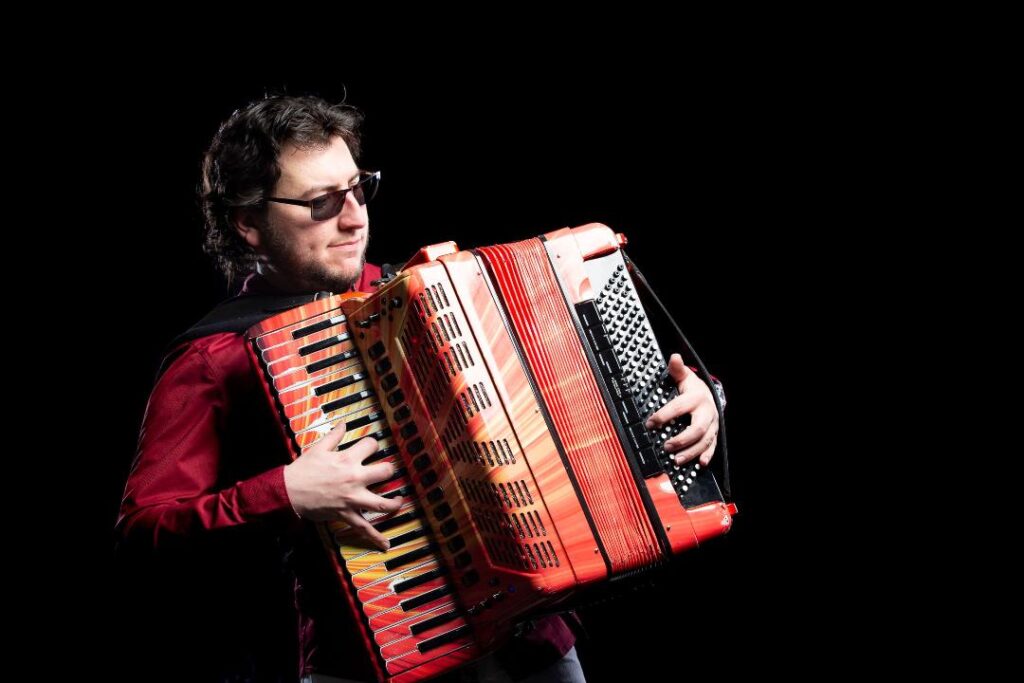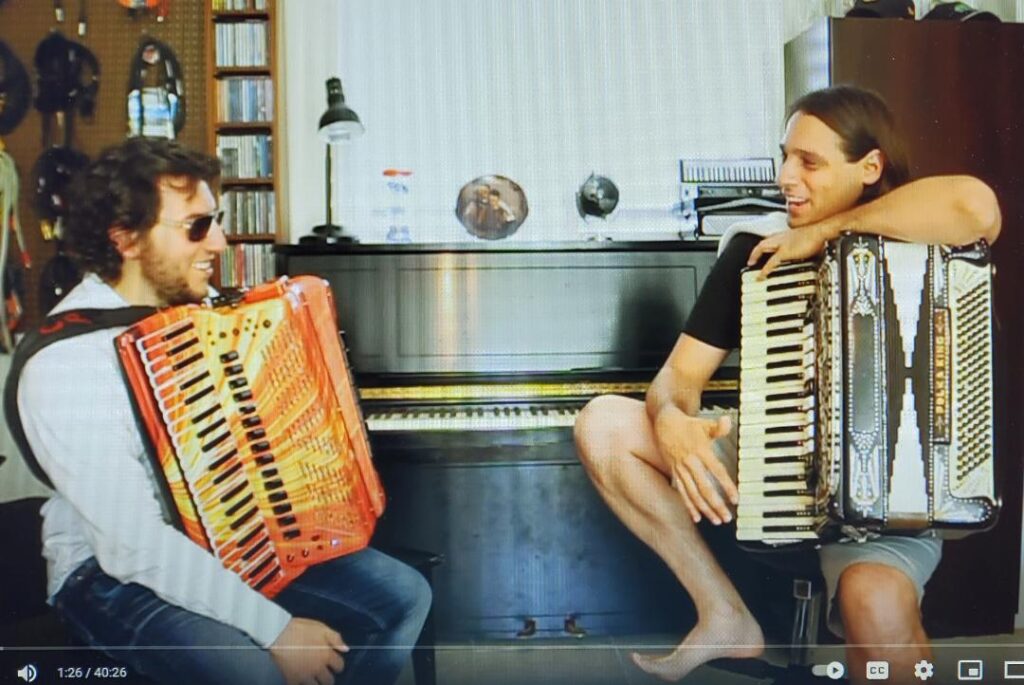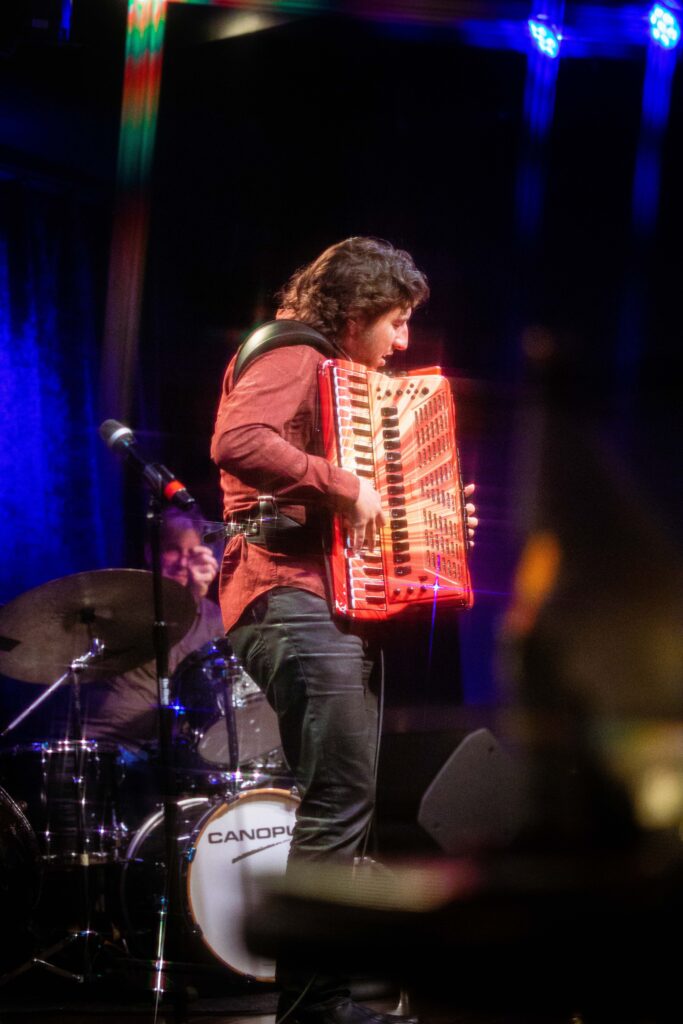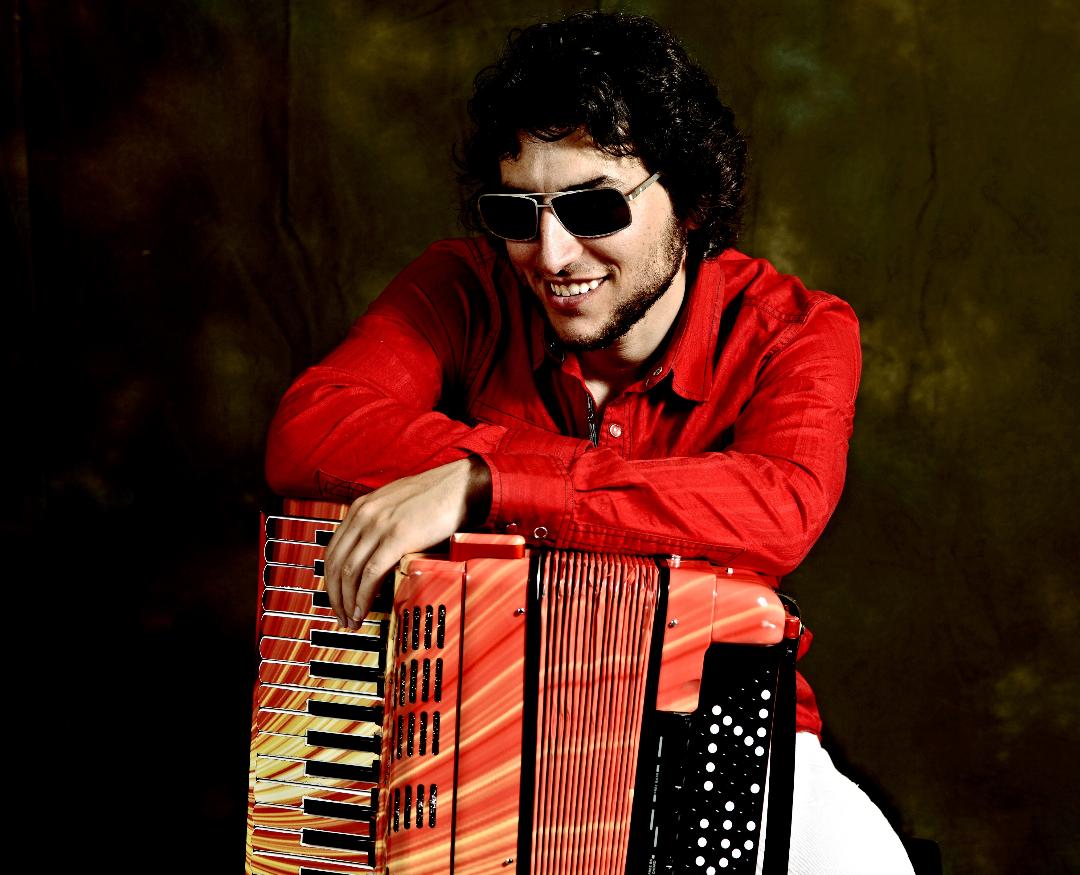Timing is everything. The accordion was once among the most popular instruments in America. Things come in and out of fashion, as younger generations seek their own aesthetics. What was cool becomes passé, until rediscovery. In the wake of the British Invasion, accordions, once prevalent in American culture, were square seemingly overnight.
The offspring of the Boomer generation grew up in a world where accordions were mostly used for novelty or within certain ethnic enclaves. This absence from mainstream culture made accordions intriguing to the young and curious.
Cory Pesaturo’s generation was primed to embrace the accordion, but selling it was still an uphill battle. For one thing, as Pesaturo notes, the instrument itself looks like an air conditioner strapped to your chest. And the musical baggage is very real.
In 2005, Roland released their digital V-Accordion. “The first one that came out was a revolutionary accordion,” says Pesaturo, “But the second generation, the one I play today, was miles ahead of the first one.”
Pesaturo got his hands on the first generation V-Accordion in 2006, changing the trajectory of his career and work. Already on a mission to make the accordion cool again, Pesaturo immediately recognized the benefit of the new digital instrument. For him it was a no brainer.
“It had to be digital,” says Pesaturo, “The acoustic makes it very hard to make the accordion cool. It’s not even about if I liked it or not, it’s simply that the digital can sound like anything in the world. It’s like going from a horse and buggy to a car. It may have a lot of problems, but it’s a car.”

Pesaturo understood, even as a teenager, not to put the cart before the horse. When it came time to study at the New England Conservatory of Music, Pesaturo brought his acoustic. “I tell students, don’t you dare learn on the electric. You’ve got to go outside and play baseball with your friends, get hurt. Then when you’ve played outside for a few years you can come inside and play video games. But you gotta play the real sports first. Just like you’ve got to learn how to drive manual before you go drive an automatic.”
A musician seeking greatness must play with better players. This is a prerequisite and inherently understood in the jazz world. The solo player’s tempo ebbs and flows without other musicians to keep him within the lines. Bad habits are reinforced unchecked. This doesn’t mean you can’t play jazz alone. Pesaturo cites pianist Art Tatum, for example, as his all-time favorite musician. Tatum was that rare breed who had a total mastery of the three columns of musical excellence Pesaturo advocates: ear to the brain to the hands, or voice. Every musician who watched him play was left in awe. But Tatum was exceptional even among the masters, in that he mostly played solo. When he eventually formed a trio, drummer Jo Jones noted, “What could I add? I felt like setting my drums on fire.”
Digital or otherwise, at some point every accordion player must play polka. And polka music is no exception to the rule that you get stronger by playing with others.
“If you’re going into restaurants and playing alone, you’re just multiplying the habits you already have,” Pesaturo says, “It doesn’t mean you’re learning anything. You learn little details if you play gigs. Most polka accordion players just play the same solo gigs and don’t play with bands, and that’s dangerous. Then you’re in a bubble. You’re not really gaining anything. If you want to really learn polka music you have to go have a masterclass with Alex Meixner, or move to a country where it’s incessantly around you.”
Alex Meixner is the premiere young gun accordionist keeping polka alive. He approaches the genre with reverence and deep, intimate knowledge of its nuances and its personalities. In 2019, the two friends and colleagues met up in Meixner’s studio where Pesaturo was given that polka masterclass.
“I’ve known Alex for well over a decade,” says Pesaturo, “He takes great offense if you say polka is simple music. There are so many intricacies in polka. There’s all these rules. Just like Italian music, which is real simple, but I could get some of the top jazz players in the world and they would crap all over an Italian festival, because they don’t know the little details of the genre.”
In the video of the encounter, available on YouTube, Meixner good naturedly ribs Pesaturo, pointing out that the digital accordion can’t get the same snap on the keyboard as Meixner’s acoustic. It is worth noting that the electric accordion is not meant to wholly replace the acoustic any more than an electric guitar is meant to replace an acoustic guitar. They are different tools, each with their own attributes. As Pesaturo says, “You don’t use a Ferrari for what you use an F350 for, and vice versa. The player must choose which best serves his musical vision.”

In his own work, Pesaturo uses the sounds available in his V-Accordion to turn his left hand into a rhythm section while his right comps organ, creating a jazz trio effect. With the scat-vocal “doo-wop” setting, his accordion becomes an acapella vocalese harmony group, ala the Manhattan Transfer or Lambert, Hendricks & Ross. He makes a statement before he even plays, brandishing his red, custom skinned finish, complete with MIDI light show and custom “C-Pez” button rows.
Purists frowned on the digital accordion when it first came out. In Pesaturo’s view, the guardians of traditional accordion, however well meaning, were in effect hastening the demise of the very thing they loved. By keeping the accordion in its perceived place — that of “old people who sit down and play boring music” — they ensure that fewer young people will take an interest in the instrument. Pesaturo’s embrace of the digital accordion was not from animus for its analog ancestor, but love. His entire career has been about reinventing not only the way the accordion is played, but the way it is perceived. He saw the V-Accordion as a vehicle “to save the accordion.”
To have his electric innovations taken seriously, he knew he had to master the instrument. To gain acceptance by the Old Guard, he had to excel on their turf.
“I’ve tried to be regarded as one of the greatest players in the world,” he says, “While simultaneously being one of the most innovative and unique players. I’m trying to straddle both. I want to be unattackable. You can hate me, but you can’t disrespect me. You can hate everything I’m going to do in my career, but you know I belong in the elite circle.”

Pesaturo’s revolution is fueled by his belief that the accordion, whether digital or acoustic, comprises all of music and our engagement with it. “The acoustic is enough,” he says, “but the electronics amplify why the accordion is the best instrument massively. The bass and chords on the left hand is all of your music theory 101. The piano on the right hand, which most people say is the most important instrument to understand music theory, is only one third of the accordion. And the bellows is everything. Combine that with electronics and the humanistic aspect of playing the accordion and you really have the greatest instrument ever made.”
Matt Powell is a writer and musician. His work explores the interconnectivity of all music and the people who create or listen. Matt’s work has been featured in Variety, No Depression journal, No Depression online, Emmys.com, Angels Flight—literary west, Humor in America, Community Works Journal, The Happy Music Center, Style Blueprint, Scanner Zine, Buck Mason Journal, and Temporary Detective. Learn more at www.theemattpowell.com

